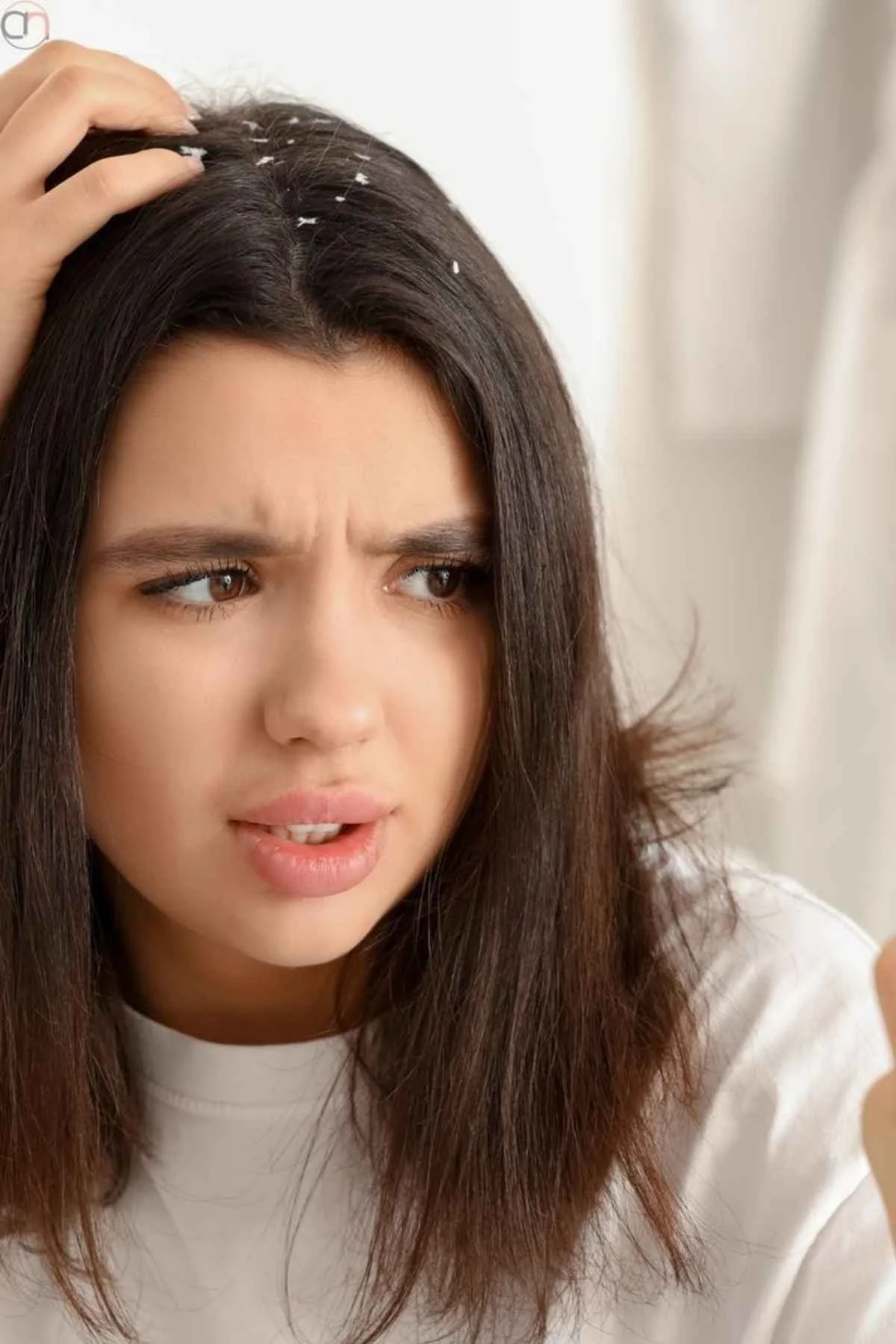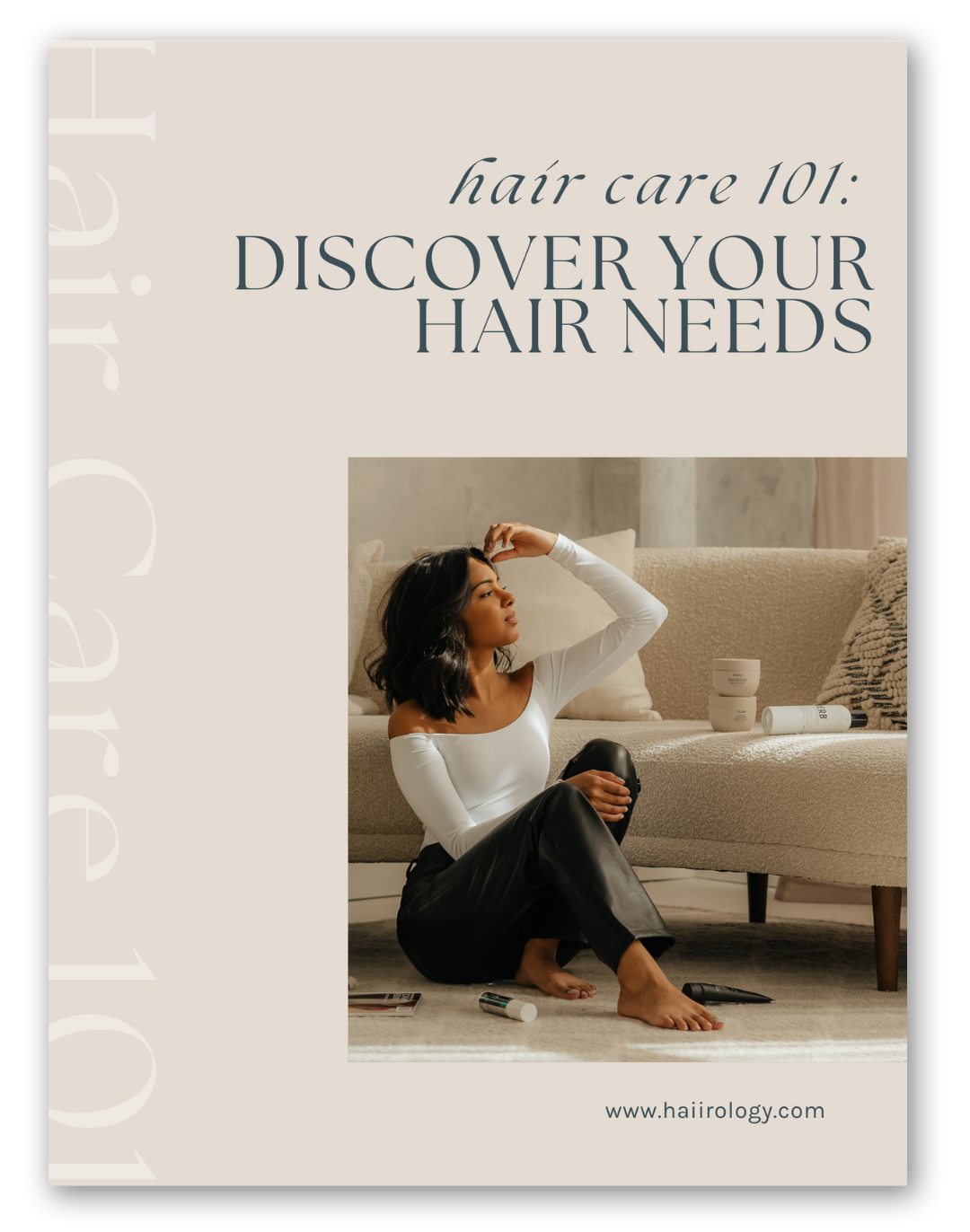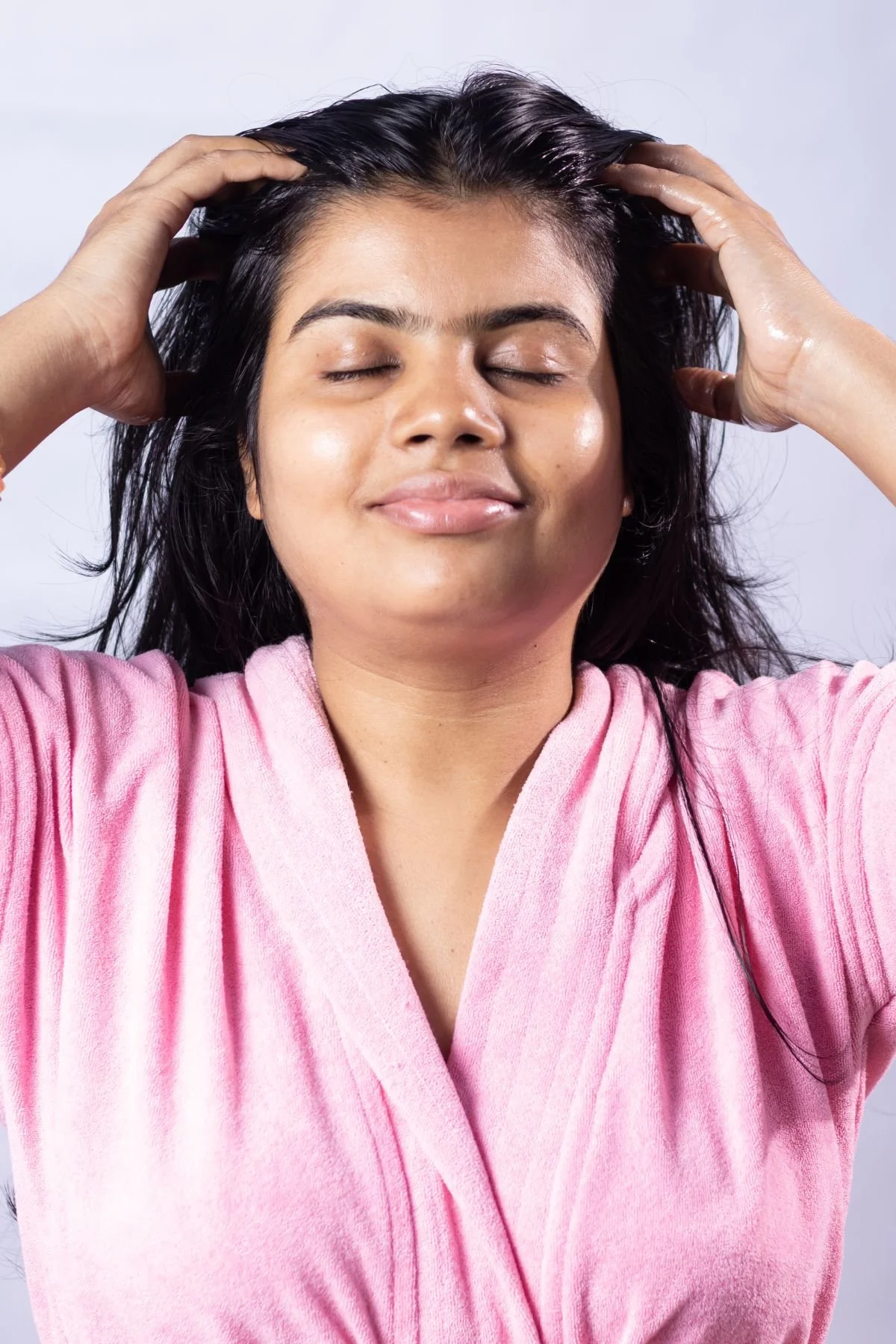Tried Everything for Hair Loss? This Scalp Care for Thinning Hair Might Be What You’re Missing
This post may contain affiliate links, which means I'll receive a commission if you purchase through the link at no extra cost to you. Please read the full disclosure here.
Ever stood in front of the mirror wondering why your hair feels thinner than it used to, especially around the crown or hairline? I’ve had so many clients tell me, “I’ve tried everything,” when in reality, they’ve tried everything except looking at their scalp. Healthy hair starts at the root. And in my 10+ years behind the chair, the biggest game-changer I’ve seen for hair thinning isn’t another styling product but proper scalp care.
In this blog post, I’m walking you through the exact scalp care for thinning hair that I recommend to clients every single day. We’ll cover what’s going wrong, what your scalp’s trying to tell you, and how to build a routine that supports regrowth without spending hours or hundreds of dollars. If you’re ready to start fresh from the root up, let’s get into it.
Why Your Scalp Health Is the Reason for Thinning Hair
Most people think thinning hair starts with their strands but as a stylist, I can tell you that’s rarely the root cause. If your scalp isn’t healthy, your hair won’t be either. And yet, so many women focus on masks, serums, and thickening sprays without ever checking in on the condition of their scalp.
A healthy scalp should feel calm, balanced, and free of irritation. It shouldn’t feel itchy, tight, flaky, or overly oily. You also shouldn’t be seeing redness or sore spots. When I work with clients who are losing hair, it’s usually not just the shedding I notice, it’s the scalp telling the real story.
The scalp gets buildup from products, oil, and dead skin which blocks follicles. This prevents new hair from pushing through properly. Inflammation, whether from scalp conditions, harsh shampoos, or even tight hairstyles, can also shrink follicles over time. Add poor circulation into the mix, and you’ve got an environment where hair simply can’t grow the way it’s supposed to.
In the salon, I can often spot thinning early before clients even notice. I’ll see congestion around the follicles, patches where hair density is dropping, or signs of irritation around the crown or hairline. Many say, “My hair just won’t grow past this point,” but really, the scalp is under stress.
If any of this sounds familiar, know that it's fixable. With the right scalp care, you can start creating the conditions your hair needs to grow stronger and fuller again.
Source: Pinterest
How to Cleanse Your Scalp Gently but Effectively
Let’s start with shampoo because yes, how you wash your scalp plays a huge role in thinning hair. It’s easy to think the more you wash, the cleaner and healthier your scalp will be. But overwashing can dry it out and disrupt your natural oil balance. On the flip side, not washing enough leads to buildup that clogs your follicles and blocks healthy growth.
You have to find that sweet spot. Most of my clients with thinning hair do well washing 2–3 times a week. If your scalp is oily or flaky, you might need to wash it a bit more often but gently.
👉 Not sure if you're washing your hair the right way? Check out my guide on Hair Washing Mistakes to discover common errors and how to fix them for healthier, shinier locks!
Source: Pinterest
Many volumizing or “strengthening” shampoos contain harsh detergents or heavy silicones that coat the scalp and make things worse. I always tell my clients to avoid sulphates, silicones, and thick waxy ingredients as they tend to clog more than they help.
Instead, look for formulas with ingredients like rosemary, caffeine, peppermint, or gentle surfactants that cleanse without stripping. These ingredients help stimulate blood flow to your scalp while keeping the environment clean and balanced.
My Favorites
Here’s what I recommend most to my thinning-hair clients: a gentle clarifying shampoo once a week, paired with a scalp-focused everyday cleanser for regular use. PEPTIDE PREP™ Clarifying Detox Shampoo and AG Care Apple Cider Vinegar Shampoo are two that consistently leave the scalp feeling fresh without that tight, dry feeling.
Exfoliate Weekly to Unclog Scalp Follicles and Boost Circulation
If you’re not exfoliating your scalp, you’re likely missing one of the most underrated steps for regrowing healthier, fuller hair. Just like your skin, your scalp needs help shedding dead cells, leftover products, and excess oil. When that buildup sits on your scalp too long, it clogs your follicles. And clogged follicles = blocked hair growth.
Now, let’s clear up a common mix-up: A flaky scalp doesn’t always mean a dry scalp. Sometimes, it’s buildup from styling products or even dry shampoo that’s causing the flaking, not a lack of moisture. That’s why exfoliating (not just oiling or moisturizing) is often the fix.
There are two main types of scalp exfoliants:
Physical exfoliants use fine granules or gentle scrubbing tools to lift buildup manually.
Chemical exfoliants use ingredients like salicylic acid or fruit enzymes to dissolve it.
If you have an oily, flaky, or congested scalp, you’ll probably benefit from a combo of both but gently. Once a week is usually enough for most people.
My Favorites
I often recommend a pre-shampoo scalp scrub that uses fine, non-abrasive grains for a physical exfoliation boost. If you prefer something leave-on, a scalp serum with gentle acids like The INKEY List Glycolic Acid Exfoliating Scalp Scrub works wonders. I always steer clear of anything that feels harsh or smells super strong—your scalp isn’t the place for extreme treatments.
How to Massage Your Scalp to Stimulate Hair Growth
You don’t need fancy treatments to start improving hair growth, just your fingertips and a few minutes a day. Scalp massage works by boosting blood flow to your follicles, which brings oxygen and nutrients to the area where your hair grows. And when your circulation improves, so does your growth potential.
The trick is to be consistent and gentle. I always remind clients that this isn’t about digging in with your nails (please don’t). That causes micro-scratches and irritation. Instead, use the pads of your fingers and move in small, circular motions across the scalp. Keep the pressure firm but comfortable.
Here’s the exact method I walk clients through:
Start at the front hairline and work your way back.
Use both hands to create overlapping circles across the scalp.
Spend extra time where you’re noticing thinning, usually the crown or temples.
Do this for 3–5 minutes daily, ideally before applying any growth treatments or oils.
My Favorites
For a boost, I love pairing massage with a lightweight oil or scalp serum. Look for ingredients like peppermint, rosemary, or tea tree as they naturally encourage circulation. BondiBoost Intensive Daily Scalp Spray for Thinning Hair with Rosemary is a great one that absorbs quickly and doesn’t leave hair greasy. You can also use a gentle silicone scalp massager like Vegamour GRO Scalp Massager if your hands get tired.
Source: Pinterest
Treat Your Scalp With Growth-Boosting Ingredients That Actually Work
Targeted scalp treatments fasten the regrowth of stronger hair. Shampoo and exfoliation lay the foundation, but it’s what you apply afterward that feeds the follicles.
The tricky part? Not all “growth” products are created equal. I always tell my clients to flip the bottle over and look at the ingredients, not the hype.
The ones worth your time usually include:
Peptides: Help strengthen hair at the root.
Caffeine: Stimulates blood flow to follicles.
Niacinamide: Calms inflammation and supports barrier health.
Rosemary extract: Shown to support regrowth over time.
Probiotics or fermented ingredients: Great for balancing the scalp microbiome.
Now here’s where things get interesting: oils alone won’t regrow hair. I know they’re popular (and they can be helpful for dryness or massage), but if you’re dealing with true thinning or slow regrowth, lightweight serums with active ingredients are much more effective. Oils sit on the surface whereas serums go deeper.
When using a treatment, always apply it after washing and gently towel-drying your hair. Massage it in with your fingertips (or a scalp tool) and let it fully absorb before adding anything else. You’ll usually start noticing a difference around the 6–8-week mark, with more visible changes by 3 months if you stay on track.
My Favorites
For clients who want results without greasy roots, I recommend a lightweight, leave-in scalp serum like Vegamour GRO Hair Serum for Thinning Hair. It doesn’t weigh down fine hair and layers well with other products. Another great option? BondiBoost Intensive Daily Scalp Spray for Thinning Hair with Rosemary if you prefer something with rosemary and caffeine in a water-based formula.
Soothe Itchy, Oily, or Flaky Scalps That Sabotage Growth
If your scalp constantly feels itchy, greasy, or flaky, it’s not just uncomfortable. It’s a red flag. Chronic irritation, seborrheic dermatitis, or excess oil can lead to inflammation at the follicle level. And when the scalp is inflamed, it doesn’t just feel off, it actually sheds more and grows less.
A calm, balanced scalp is essential if you’re trying to maintain density or see new growth. When your scalp isn’t fighting inflammation or suffocated by buildup, it can finally do what it’s meant to nourish your follicles and support strong, anchored strands.
👉 Struggling with an irritated scalp? Check out The Ultimate Scalp Care Routine to Soothe an Irritated Scalp for expert tips to calm and nourish your scalp!
My Favorites
If you’re dealing with irritation or oil imbalance, a lightweight scalp mist or tonic can make a huge difference. Look for something with calming ingredients like witch hazel, aloe, niacinamide, or tea tree and make sure it’s water-based and residue-free. OGX Extra Strength Refreshing + Invigorating Teatree Mint Dry Scalp Treatment is one I love for calming reactive scalps without leaving anything behind. Another go-to is OUAI Hydrating Scalp Serum, especially if you’re managing both oiliness and itchiness.
Use it on clean, towel-dried hair or between washes when you need a refresh. It takes two seconds but helps reset the scalp’s pH, reduce flare-ups, and bring things back into balance.
Source: Pinterest
Build a Weekly Scalp Care Routine You Can Stick To (Even If You’re Busy)
The secret to healthier, fuller hair? It's not doing everything but doing the right things consistently. Scalp care doesn’t have to be complicated or time-consuming. You just need a simple rhythm you can stick to, even on your busiest weeks.
Here are the four key actions your scalp needs:
Cleanse: To remove dirt, oil, and product buildup.
Exfoliate: To unclog follicles and boost circulation.
Stimulate: To increase blood flow with massage.
Treat: To nourish follicles and support regrowth.
Now let’s break that down into a realistic routine:
Low-maintenance routine (for beginners or busy weeks)
2–3x a week: Use a gentle, scalp-friendly shampoo
1x a week: Exfoliate with a scalp scrub or pre-shampoo detox
2x a week: Massage your scalp for 3–5 minutes (no tools needed!)
Every wash: Apply a lightweight growth serum to towel-dried hair
Results-Focused Routine (for targeted regrowth + scalp reset)
3x a week: Shampoo with a formula designed to support thinning hair
1x a week: Exfoliate and follow with a calming or clarifying tonic
Daily: Do a quick scalp massage with fingers or a scalp tool
Daily or every other day: Apply a targeted serum with peptides, caffeine, or rosemary
Choose the version that works for you or mix and match. The most important thing? Be consistent, even if it’s just 2 or 3 small steps a week. You’ll start to see and feel the difference in your scalp first... and then in your hair.
Source: Pinterest
Support Your Hair From Within with Nutrition and Smart Supplements
No matter how good your scalp routine is, it won’t do the full job if your body’s running low on the nutrients that support healthy hair growth. I’ve seen this over and over with clients that when we dig deeper, there’s often an internal piece that needs attention.
The most common deficiencies I see in women with thinning hair?
Iron: Low levels can slow or even stop hair growth.
Vitamin D3: A major player in the hair growth cycle.
Biotin: Supports keratin production, especially helpful for brittle strands.
Zinc: Helps regulate the scalp’s oil production and healing.
If your hair is shedding more than usual, feels slow to grow, or looks dull despite your best efforts topically, it might be time to consider your nutrition. Hormonal changes (like postpartum, PCOS, or perimenopause) can also play a huge role. So can stress, poor sleep, or restrictive diets.
My Favorites
I recommend choosing clean, well-formulated supplements that support your hair. I often suggest Vegamour GRO Biotin Gummies for Thinning Hair because while taking it, my hair feels stronger and grows faster.
For clients dealing with hormonal shifts and who aren’t sure what they need, a blood test can be a great first step for iron, ferritin, and vitamin D. From there, you can be more intentional about giving your hair what it’s really asking for.
Source: Pinterest
Avoid Common Mistakes That Make Hair Thinning Worse
Sometimes it’s not just what you aren’t doing, it’s what you are doing every day without realizing it’s making things worse. Let’s go over a few of the biggest culprits:
Blow-drying too aggressively
High heat and rough brushing can fry fragile strands, especially around the hairline and crown. Always use a heat protectant and dry on medium heat, focusing the airflow downward. Avoid yanking at roots when wet, that’s when hair is most vulnerable.
Overusing dry shampoo
I know it’s a lifesaver for busy mornings, but dry shampoo can clog follicles and suffocate the scalp if it builds up too often. If you’re reaching for it daily, it might be time to reassess your wash routine and reach for a scalp-refreshing tonic midweek instead.
Tight buns, ponytails, and extension tension
Constant pulling puts stress on your follicles and leads to traction alopecia over time. The damage usually shows up along the hairline or nape, where the hair is naturally finer.
Friction from pillowcases
Cotton pillowcases can rough up the cuticle and cause breakage. Switching to silk or satin pillowcases helps reduce tangling, especially for thinning or fragile hair.
What To Do Instead
Instead of tight top knots, I love recommending loose braids or low-claw clips for off-the-face styling. For added volume without teasing or heat, try a volumizing mousse or a root-lifting spray that’s safe for thinning scalps. And if you’re using dry shampoo more than 2–3 times a week, balance it with a gentle clarifying rinse once a week to keep your scalp breathing.
👉 Check out my guide on What Does Clarifying Shampoo Do? for when (and how) to use it for the best results!
Source: Pinterest
When to See a Dermatologist or Trichologist (And What They Can Help With)
Sometimes, scalp care and at-home routines aren’t enough on their own and that’s completely okay. If your hair thinning has been going on for a while, or if you’ve already tried everything and still aren’t seeing progress, it might be time to bring in a medical expert.
Here’s how I usually help clients decide:
Is your hair falling out in patches?
Is your scalp painful, inflamed, or showing sudden changes?
Have you been consistent with scalp care for 3+ months with no real improvement?
If the answer is yes to any of these, I recommend seeing a dermatologist or a certified trichologist. They can conduct deeper tests, such as blood work, to check for nutrient deficiencies, hormone levels, or autoimmune conditions, and even perform a scalp biopsy if needed.
What I love to do is work alongside medical treatments. For example, if you’re using a medication recommended by your dermatologist, you can continue your scalp care routine with the right adjustments. I help clients build a plan that supports the medication like choosing shampoos and exfoliants that won’t irritate, or finding calming serums that pair well with topical treatments.
Think of it as a team effort: your doctor handles the inside, and I help you stay consistent with the outside.
There’s no shame in needing extra support, sometimes it’s the fastest way to real answers and real results. And combining medical insight with a strong, stylist-approved routine? That’s where the magic happens.
Source: Pinterest
| Scalp Care for Thinning Hair: Nourish at the Root |
|---|
| Healthy hair starts with a healthy scalp. Explore these expert guides to understand scalp care essentials, hair repair routines, and nourishing rituals to support thicker, fuller-looking hair: Whether you're tackling thinning hair or looking to elevate your scalp care game, these posts are full of tips to help you grow stronger from the scalp up. |
Final Word from Haiirology
Caring for your scalp isn’t a trend, it’s the foundation of healthy, lasting hair growth. If you are struggling with thinning, it’s time to shift the focus from your strands to the source. With the right scalp care for thinning hair, you can start creating the conditions your hair needs to thrive.
Start small, stay consistent, and choose products that support your scalp, not just coat your hair. If you’re ready for a routine that works with your hair goals, explore my go-to scalp picks and let your regrowth journey begin. And if you want the full step-by-step breakdown, don’t forget to download my Fee Ultimate Hair Growth & Scalp Health Guide.
To keep your hair journal ready, share the results with me on Insta, I’d love to cheer you on!























Struggling with hair loss or slow regrowth? Discover expert-approved scalp care for thinning hair that works wonders. Learn what’s causing your shedding and how to fix it with real routines, ingredients, and pro tips you won’t find anywhere else.